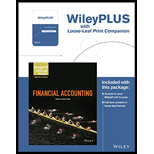
(a)(1)
Periodic Inventory System: It is a system in which the inventory is updated in the accounting records on a periodic basis such as at the end of each month, quarter or year. In other words, it is an accounting method which is used to determine the amount of inventory at the end of each accounting period.
In First-in-First-Out method, the cost of initially purchased items are considered as cost of goods sold, for the items which are sold first. The value of the ending inventory consists the recent purchased items.
In Last-in-First-Out method, the cost of last purchased items are considered as cost of goods sold, for the items which are sold first. The value of the closing stock consists the initial purchased items.
To Compute: The cost of ending inventory and cost of goods sold using FIFO.
(a)(2)
Periodic Inventory System: It is a system in which the inventory is updated in the accounting records on a periodic basis such as at the end of each month, quarter or year. In other words, it is an accounting method which is used to determine the amount of inventory at the end of each accounting period.
In First-in-First-Out method, the cost of initially purchased items are considered as cost of goods sold, for the items which are sold first. The value of the ending inventory consists the recent purchased items.
In Last-in-First-Out method, the cost of last purchased items are considered as cost of goods sold, for the items which are sold first. The value of the closing stock consists the initial purchased items.
To Compute: The cost of ending inventory and cost of goods sold using LIFO.
(b)
The costing method which gives highest ending inventory.
(c)
The costing method which gives higher cost of goods sold.
Learn your wayIncludes step-by-step video

Chapter 6 Solutions
Financial Accounting, 10e WileyPLUS Registration Card + Loose-leaf Print Companion
- Calculate the overhead expenses as a percentage of the net sales.arrow_forwardMerchandise with an invoice price of $8,500 was purchased subject to terms of 3/15, n/45, FOB destination. Transportation costs paid by the seller totaled $420. Assuming the invoice was paid within the discount period, what is the purchaser's net cost of the merchandise?arrow_forwardThe actual cost of direct labor per hour is $29.75 and the standard cost of direct labor per hour is $31.50. The direct labor hours allowed per finished unit is 1.25 hours. During the current period, 5,800 units of finished goods were produced using 7,500 direct labor hours. How much is the direct labor rate variance?arrow_forward

 AccountingAccountingISBN:9781337272094Author:WARREN, Carl S., Reeve, James M., Duchac, Jonathan E.Publisher:Cengage Learning,
AccountingAccountingISBN:9781337272094Author:WARREN, Carl S., Reeve, James M., Duchac, Jonathan E.Publisher:Cengage Learning, Accounting Information SystemsAccountingISBN:9781337619202Author:Hall, James A.Publisher:Cengage Learning,
Accounting Information SystemsAccountingISBN:9781337619202Author:Hall, James A.Publisher:Cengage Learning, Horngren's Cost Accounting: A Managerial Emphasis...AccountingISBN:9780134475585Author:Srikant M. Datar, Madhav V. RajanPublisher:PEARSON
Horngren's Cost Accounting: A Managerial Emphasis...AccountingISBN:9780134475585Author:Srikant M. Datar, Madhav V. RajanPublisher:PEARSON Intermediate AccountingAccountingISBN:9781259722660Author:J. David Spiceland, Mark W. Nelson, Wayne M ThomasPublisher:McGraw-Hill Education
Intermediate AccountingAccountingISBN:9781259722660Author:J. David Spiceland, Mark W. Nelson, Wayne M ThomasPublisher:McGraw-Hill Education Financial and Managerial AccountingAccountingISBN:9781259726705Author:John J Wild, Ken W. Shaw, Barbara Chiappetta Fundamental Accounting PrinciplesPublisher:McGraw-Hill Education
Financial and Managerial AccountingAccountingISBN:9781259726705Author:John J Wild, Ken W. Shaw, Barbara Chiappetta Fundamental Accounting PrinciplesPublisher:McGraw-Hill Education





